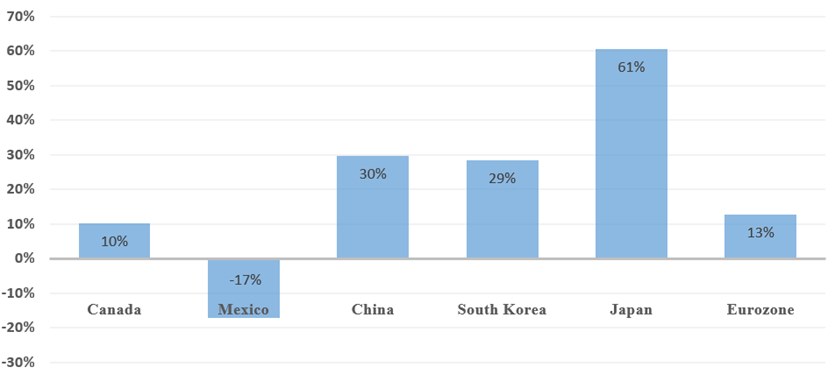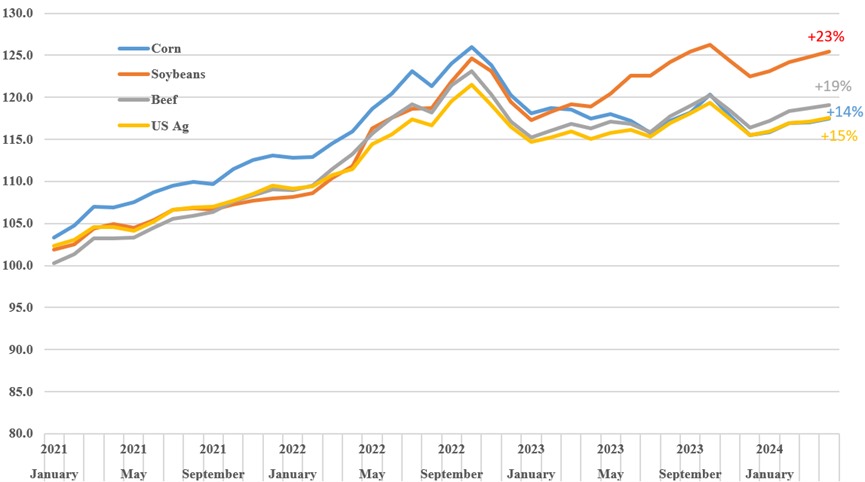By Ryan Hanrahan
The United States Department of Agriculture Economic Research Service reported Wednesday that “net farm income, a broad measure of profits, is forecast at $116.1 billion in calendar year 2024, a decrease of $39.8 billion (25.5 percent) relative to 2023 in nominal (not adjusted for inflation) dollars.”
“After adjusting for inflation, net farm income is forecast to decrease $43.1 billion (27.1 percent) in 2024 relative to 2023,” the ERS wrote. “With this expected decline, net farm income in 2024 would be 1.7 percent below its 20-year average (2003–22) of $118.2 billion and 40.9 percent below the record high in 2022 in inflation-adjusted dollars.”

If the estimate holds, that would mark the biggest year-over-year drop since 2006,” according to Bloomberg reporting by Ilena Peng.
“‘USDA’s lower net farm income estimates for 2023 and 2024 reflect the transition of going from corn prices above $6.00 and soybean prices near $15 in early 2023 to less than $4.50 for corn and less than $12 for soybeans today,’ DTN Lead Analyst Todd Hultman said,” according to reporting from Progressive Farmer’s Katie Micik Dehlinger.
Farm Operator Household Median Income
“Median total farm household income is forecast to have increased to $99,523 in 2023,” the USDA ERS reported. “That is a nominal increase of 4.3 percent (a 0.7-percent increase after inflation) between 2022 and 2023. In 2024, median total farm household income is forecast to decrease to $99,445. That is a nominal decrease of 0.1 percent (a decrease of 2.2 percent after inflation) between 2023 and 2024.”

In addition, “many farm households primarily rely on off-farm income,” the USDA ERS reported. “Median off-farm income in 2023 is forecast at $84,224, an increase of 3.8 percent (0.2 percent after inflation) from $81,108 in 2022. Median off-farm income in 2024 is forecast to increase to $86,555, an increase of 2.8 percent from 2023 (0.6 percent after inflation).”
Estimates Reflect Lower Crop Prices
Micik Dehlinger reported that “increased supplies of crops will help the livestock industry and keep both feed and food costs down.”
“‘But the painful part of this transition is that for many corn growers, cash prices in the low or even mid-$4s will not be profitable in 2024, and the protective levels of crop insurance will likely be too low to help,’ he (DTN Lead Analyst Todd Hultman) said,” she wrote.
In addition, Micik Dehlinger reported, “Sen. John Boozman, R-Ark., ranking member of the Senate Agriculture Committee, pointed to the decline in farm income Wednesday as a reason to increase the commodity safety net.”
Agriculture Secretary Tom Vilsack said in a press release that “the forecast underscores the critical importance of USDA’s ongoing work to help foster prosperity for producers and the communities they love by supporting an economy that grows from the bottom up and the middle out, and by creating new market opportunities that promote competition in the marketplace that can help combat low prices and high input costs.”
Source : illinois.edu